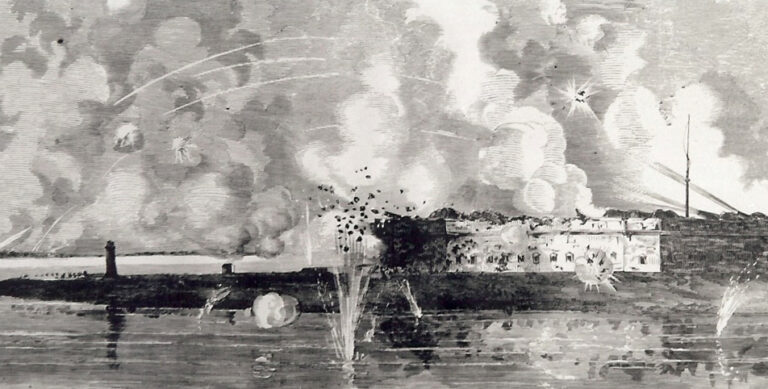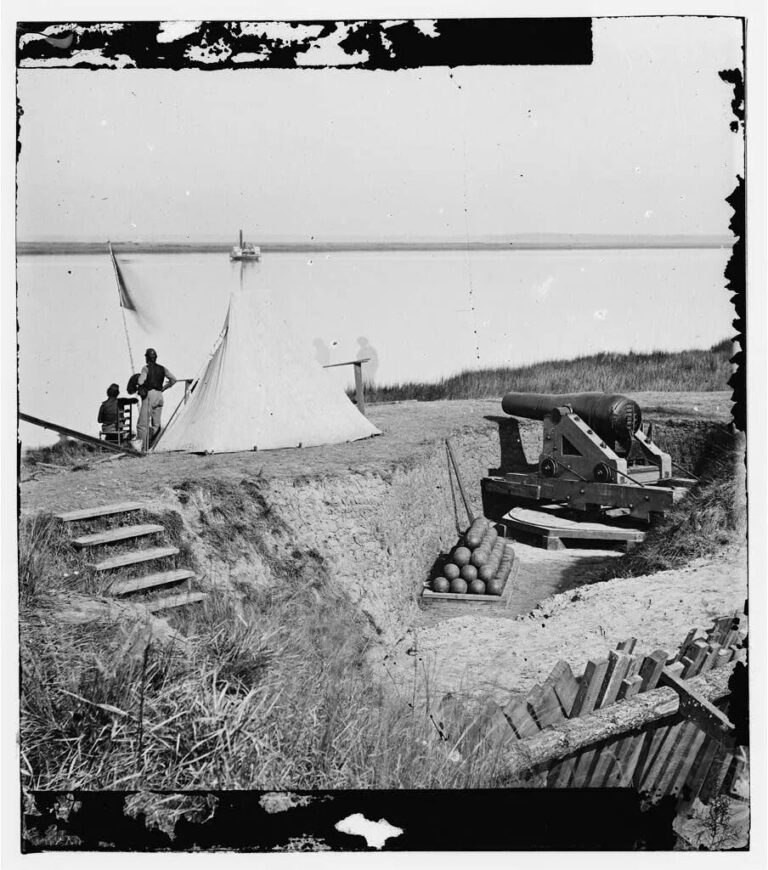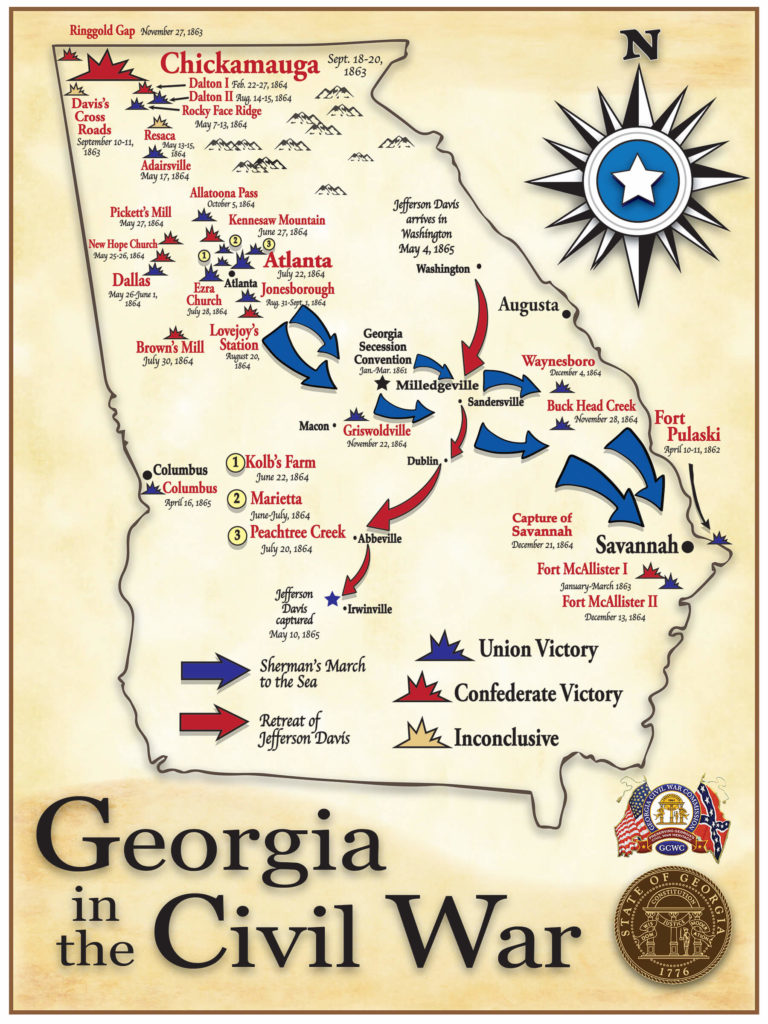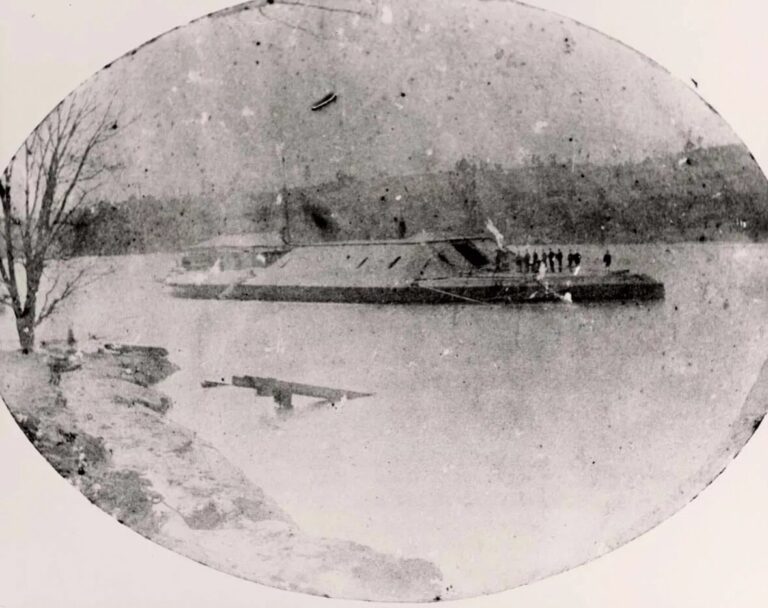
1861
- January 1, 1861- Georgians go to the polls to vote on either a pro-Union or pro-Secession slate of delegates for the state convention to be held in Milledgeville. The referendum is won by the pro-Secession vote.
- January 3, 1861- Georgia militia under General Francis Bartow seizes Federal government property
including Fort Pulaski. - January 19, 1861- Georgia votes to leave the Union at the Secession Convention in Milledgeville.
- January 22, 1861- A “statement of protest,” is issued by the six convention delegates who refused to
sign the Ordinances of Secession. - September 11, 1861- Joseph E. Brown elected to a third term as governor.
Pictured: Republic of Georgia. Ordinance of secession, passed January 19, 1861. with the names of the signers. An ordinance to dissolve the Union between the State of Georgia

Pictured: The bombardment of Fort Pulaski-Second day, Friday, April 11th, 1862. (cropped) “Fort Pulaski Under Fire,” April 1862, Frank Leslie’s Weekly Magazine View of Union bombardment from the North Channel of the Savannah River, northeast of the fort. The southeast corner has brick and mortar blasted into the air by conical high explosive shells from five Parrott Rifle cannons in Battery Sigel, Tybee Island, Georgia.
1862
- February 10, 1862 – General Robert E. Lee requests permission from Governor Joseph E. Brown to dismantle the Confederate batteries on Jekyll Island as the inhabitants had abandoned the island. The guns are sent to strengthen the defenses around Savannah.
- March 9, 1862 – Federal troops occupy Jekyll Island.
- April 10-11, 1862 – The Battle of Fort Pulaski occurs. Areas of the fort are reduced to rubble by the use of rifled cannons by the Federals under Brigadier General Quincy A. Gillmore, thus forever ending the era of the masonry fort.
- April 12, 1862 – Union raiders in civilian clothing seize the Confederate engine General at Big Shanty on a mission of sabotage. The plot falls apart due to rain, poor decision-making and a tenacious band of Confederates in hot pursuit. The raiders were captured but later received the first Medals of Honor (some posthumously) bestowed by the U.S. Government.
- July 1862 – The Griswold Cotton Gin Company produced their first Colt patterned revolvers under a Confederate contract.
- July 1, 1862 – Federal Navy assault on Fort McAllister.
- July 29, 1862 – Federal Navy assaults Fort McAllister.

Pictured: A signal station on the Ogeechee River at Fort McAllister. After General William T. Sherman’s Union troops occupied Fort McAllister on December 13, 1864, personnel were ordered to dismantle the stronghold in preparation for Sherman’s march northward.
1863
- January 27, 1863- Federal Navy assaults Fort McAllister
- February 28, 1863 – Federal gunships including the Monitor U.S.S. Montauk moved up the Ogeechee River past Fort Pulaski to destroy the Confederate privateer Rattlesnake (formerly Nashville).
- March 3, 1863 – Federal Naval assaults on Fort McAllister resume.
- May 3, 1863 – Confederate General Nathan Bedford Forrest captures Colonel Abel Streight’s raiders in Western Alabama before they reach their goal of Rome, Georgia.
- June 11, 1863-The coastal town of Darien is burned by the USCT of the 54* Massachusetts.
- September 19-20, 1863 – The Battle of Chickamauga ends in Confederate victory and leads to the siege of Chattanooga.
- October 10, 1863 – Jefferson Davis arrives in north Georgia to visit with Army of Tennessee commander General Braxton Bragg and to mediate a growing feud between Bragg and his generals.
- November 27, 1863 – Federal pursuit of the Confederate Army of Tennessee fleeing Chattanooga is stopped by the ambuscade under Major General Patrick Cleburne at the Battle of Ringgold Gap.
- December 16, 1863 – Confederate General Braxton Bragg resigns command of the Army of Tennessee and is replaced by General Joseph E. Johnston at Dalton. The Army of Tennessee spends the winter of 1863-64 headquartered at Dalton.

1864
- January 2, 1864 – Major General Patrick Cleburne presents a proposal to the Army of Tennessee high command to offer freedom to slaves who would volunteer to fight for the Confederate army. A topic of great controversy, the proposal presented at the Dr. James Black house in Dalton never got off the ground.
- February 22-27, 1864 – General George Thomas probes Confederate lines around Dalton after General Joseph E. Johnston dispatched two divisions to aid Lt. General Leonidas Polk in the West. Thomas withdrew on February 27 after realizing Johnston could counter any Federal threat.
- May 5- 7, 1864 – The Atlanta Campaign begins as the Federal XIV Corps drives the Confederate outpost from Tunnel Hill to Buzzard’s Roost.
- May 8-11,1864- The Battles of Rocky Face Ridge and Dug Gap occur while Federal troops probe Buzzard’s Roost Gap in unsuccessful attempts to dislodge the Confederates.
- May 8 -13, 1864 – General James B. McPherson attempts a flanking movement around Confederate forces at Dalton through the Snake Creek Gap establishing the pattern for the entire campaign. The plan was to get between the Confederate Army and Atlanta at Resaca. A small force of Confederates stationed at Resaca causes McPherson to hesitate and lose the advantage.
- May 14-15, 1864 – The Battle of Resaca ends in a draw but the Confederate Army is forced to head south to protect its flanks.
- May 16, 1864- Battle of Rome Crossroads and fighting near Calhoun.
- May 17, 1864 – Fighting at Adairsville and in the vicinity of Rome.
- May 18-19,1864 – General Johnston’s attempted assault on a portion of General Sherman’s pursuing forces at Cassville falls short when Lt. General John B. Hood, fearing a threat on his flank, fails to act.
- May 20, 1864 – The Etowah River is crossed as the Federal Army moves ever closer to Atlanta; However, General Sherman, wishing to avoid a frontal assault on well-entrenched Confederates in the Allatoona Mountain range, leaves the railroad and attempts to flank Johnston to the west.
- May 25, 1864 -The Battle of New Hope Church occurs after Confederates rush west into Paulding County to meet General Sherman’s threat there. Heavy casualties result after two hours of fighting stops the Federal advance.
- May 26-June 1,1864 – Fighting on the New Hope- Dallas line in Paulding County as the Atlanta Campaign becomes a war of entrenchment.
- May 27, 1864 – A Federal flanking movement is stopped with heavy casualties at the Battle of Pickett’s Mill.
- June 14, 1864- Lt. General Leonidas Polk is killed atop Pine Mountain.
- June 9-23, 1864 – Operations west of Marietta including fighting at Pine Mountain, Lost Mountain,Brushy Mountain, Gilgal Church, Mud Creek, Noonday Creek, and Noyes Creek. The Confederates are forced back to the “Gibraltar of Georgia, “the Kennesaw Mountain Line.
- June 22, 1864 – At the Battle of Kolb’s Farm Hood’s assaults are all stopped with a bloody repulse, though the Federal flanking movement around Kennesaw Mountain is temporarily averted.
- June 27, 1864 – The Federals launch a morning assault on what are considered weak points in the Confederate line and are repulsed at all points with heavy losses at the Battle of Kennesaw Mountain.
- July 3-4, 1864- The Confederate army abandons the Kennesaw line to avoid a Federal flanking movement and moves back to the Smyrna- Ruff’s Mill Line. Federals assault the line at both Smyrna Station and Ruff’s Mill.
- July 5-9, 1864 – The Johnston’s River line is occupied. The Federals build a line parallel and constant skirmishing ensues.
- July 5-17,1864 – Operations along the Chattahoochee River with fighting at Howell’s, Turner’s and Pace’s Ferries.
- July 18, 1864 – General Joseph E. Johnston, after having failed to stop the Federal advance towards Atlanta, is relieved of command by President Jefferson Davis and replaced by Lt. General John B. Hood.
- July 18-20, 1864- Operations commence around Peachtree Creek that includes fighting at Moore’s Mill and at Green Bone Creek and east of the city at Stone Mountain.
- July 20, 1864-The Battle of Peachtree Creek is the first of Hood’s three unsuccessful sorties during July designed to piecemeal destroy elements of Sherman’s army.
- July 21, 1864- Combat for control of Leggett’s Hill
- July 22, 1864 – The Battle of Atlanta and the Battle of Decatur. Federal Maj. General James B. McPherson and Confederate Maj. General W.H.T. Walker are killed.
- July 22-24, 1864- Federal General Kenner Garrad’s cavalry raid on Covington.
- July 23-August 26, 1864 – Siege operations begin and last through most of August.
- July 27-31, 1864- Brigadier General Edward McCook leads cavalry raid on the Atlanta & West Point and Macon &Western Railroads.
- July 28, 1864- The Battle of Ezra Church
- July 30, 1864- Battle at Dunlap Farm and shelling of Macon by Stoneman’s raiders.
- July 31, 1864- Battle of Sunshine Church. Maj. General George Stoneman and 600 men surrender to Confederate Brig General Albert Iverson.
- August 3, 1864 – Battle of King’s Tanyard.
- August 5-7, 1864- Battle of Utoy Creek. Fighting around Atlanta’s West End.
- August 10- September 9, 1864 – Confederate General Wheeler’s cavalry raid into North Georgia and East Tennessee.
- August 18-22, 1864 – Federal General Judson Kilpatrick’s raid on Lovejoy Station.
- August 31-September 1- Battle of Jonesboro – General Hood’s 80 railroad cars of munitions is exploded.
- September 2, 1864- Federal troops occupy Atlanta.
- September 25, 1864- President Jefferson Davis visited General Hood’s headquarters at Palmetto to confer on the military situation after the fall of Atlanta.
- September 28, 1864- President Jefferson Davis wires Hood from West Point, GA to relieve Lt. Gen. Hardee from the Army of Tennessee and send him to command the Department of South Carolina, Florida, and Georgia. Hardee’s new assignment would be headquartered in Savannah.
- October 5, 1864- Following several days march north from Palmetto, General Hood dispatches Maj. Gen.French’s division to capture the Federal garrison at Allatoona Pass. After severe combat, the French withdraw without the garrison’s capitulation.
- November 8, 1864- Lincoln is reelected as President of the United States.
- November 15, 1864- Maj. Gen. W.T. Sherman, after organizing his army into a right wing and a left wing, begins his double-pronged march across Georgia from Atlanta to Savannah. All items of use to the Confederates in the City of Atlanta are burned.
- November 19,1864-Gov. Joe Brown called for all men between the ages of sixteen and fifty-five to oppose Sherman, but was unable to raise a significant force.
- November 22, 1864- The Battle of Griswoldville ends in Confederate defeat. The state capitol at Milledgeville falls to the Federal invaders.
- November 28, 1864- Cavalry action at Buckhead Creek and Reynolds Plantation.
- December 4, 1864- The Battle of Waynesboro
- December 7, 1864- The Ebenezer Creek incident occurs at the Augusta/Savannah causeway crossing.
- December 13, 1864- Fort McAllister falls leading to the evacuation of Savannah.
- December 16, 1864- Doctortown, on the Altamaha River is successfully defended against several Federal assaults.
- December 20-21, 1864- The City of Savannah falls to the invading Federals while Lt. Gen. Hardee’s army escaped into South Carolina.

1865
- April 16.1865- Brig. Gen. James H. Wilson’s Federal raiders enter Georgia and attack at West Point and Columbus. The Battle of West Point ends with the fall of Fort Tyler and the death of Brig. Gen. Robert C. Tyler. Columbus is captured and its naval works are burned along with the ship CSS Jackson.
- May 10, 1865- Confederate President Jefferson Davis is captured near Irwinville.
- May 12, 1865 – Confederate Brig. Gen. William T. Wofford surrendered the last significant body of Confederate troops in Georgia to the Federals, ending the war in Georgia.